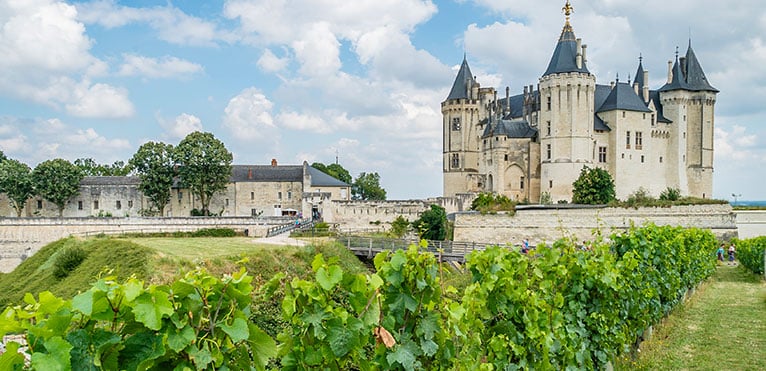
Contents
Cabernet d’Anjou is a wine appellation from the Loire Valley region, and more specifically from the Anjou-Saumur vineyards. You’re probably familiar with this region, which is one of France’s jewels when it comes to vineyards. The Anjou appellation is also found in this region, but the two appellations are quite different! Cabernet d’Anjou, the name given to rosé wines, benefits from both AOC (Appellation d’Origine Contrôlée) and AOP (Appellation d’Origine Protégée) labels, and is the only rosé to have an appellation in France.
Cabernet d’Anjou, nominated several times!
Cabernet d’Anjou is an essential part of French winemaking expertise. In volume it is France’s second-largest rosé appellation, and undeniably one of the country’s finest! The Cabernet d’Anjou appellation has initially was recognized as an AOC by the decree of October 18, 1950, then known as “Anjou-Saumur Rosé de Cabernet”. It wasn’t until May 9, 1964, that the wine was given its current name: Cabernet d’Anjou!
Today, it produces over 226,000 hectolitres a year, and has won numerous awards in the 20th and 21st centuries. The years 1971, 1976, 1978 and 1995 are considered exceptional vintages for Cabernet d’Anjou. The year 1989 was even awarded the title of Cru du Millénaire!
The AOC Cabernet-d’Anjou terroir straddles 3 départements
Cabernet d’Anjou is grown in the départements of of Deux-Sèvres, Maine-et-Loire and Vienne. In total, no less than 4,450 hectares are home to this precious vineyard. The Cabernet d’Anjou terroir benefits from a temperate climate with an oceanic influence.
As far as soils are concerned, Cabernet d’Anjou has a very interesting mineral richness. In the Anjou Noir region, soils are dark and composed of slate and carboniferous schists, particularly in the Segréen and Mauges regions west of Angers. In Anjou Blanc, however, the soils are light and white – a direct consequence of the chalk’s weathering. It’s interesting to note that the vines find their optimum expression when they come from the banks of the Layon, whose soils are mostly schist and falun (i.e. rocks made up of shells). The grapes are then picked when ripe and vinified respecting local traditions.
Cabernet-d’Anjou, a sweet, fruity wine with remarkable aromas
The grape varieties used for Cabernet d’Anjou are Cabernet Franc and Cabernet Sauvignon. It has an elegant, rather timidly intense color, coquettishly pink, salmon pink or eglantine. With age, its coat takes on a tile-like hue.
The nose reveals aromas of red fruit – such as redcurrant and raspberry – and yellow and white fruit such as peach and pear. Remarkably rich, with nuances of exotic fruit, as well as surprising vegetal nuances – bell pepper, for example – spicy – white pepper – and floral – rose. The best vintages can even develop candied orange aromas!
On the palate, Cabernet d’Anjou reveals a remarkable aromatic intensity and balance that leave a lasting impression, fully expressing its fresh, suave character. These wines are soft – they contain at least 10g of sugar per liter – and fresh at the same time. Cabernet d’Anjou, for example, has a generous roundness on the palate, followed by a fine liveliness. In sunny vintages, we note a remarkable mellowness tinged withcandied fruit aromas and spicy notes.
Cabernet d’Anjou has an ageing potential of 1 to 2 years, and up to 5 years in certain vintages.
Cabernet d’Anjou, a sure-fire summer ally!
Cabernet d’Anjou is definitely a pleasant thirst-quenching wine, remarkably fresh and fruity. Tender, round and suave, it’s the perfect match for all your summer cravings.
As an appetizer, it’s a perfect accompaniment to a sweet and savory tasting experience, such as melon with Bayonne ham, the must-have summer starter.
As a main course, Cabernet d’Anjou goes international! In fact, it’s sure to satisfy your culinary wanderlust, as it blends perfectly with any world cuisine. You could serve it with a chicken and chorizo risotto, for example, if you’re in the mood for something Italian. If you’re feeling more in the mood for Asian cuisine today, it’s also the perfect accompaniment to a chop suey!
For dessert, don’t hesitate to indulge! Red fruits and chocolate are the perfect allies for Cabernet d’Anjou. Why not try making a raspberry tiramisu for the occasion?
2 Cabernet-d’Anjou estates of excellence
Château des Fesles
Château des Fesles is a true family story. The Bovin family, true wine enthusiasts, acquired the property in the 19th century and developed the vineyard over three generations. Today, the 50-hectare estate continues to offer wine lovers all the richness of its terroir. Close to the Layon, the formation of morning fog favors the development of Botrytis, a fungus that produces highly concentrated grapes. This element is essential in the making of Bonnezeaux. Above all, the Château insists on quality, a real watchword and objective.
Domaine de la Bougrie
Since launching a major restructuring process in 2008, Domaine de la Bougrie has been striving for excellence in the development of its wines. The entire team working on the estate is dedicated to providing precise, meticulous work to offer wine lovers a unique quality of wine. In addition to this aspect, the estate has not forgotten its responsibility to the environment, and is committed to more sustainable production. Today, the estate is certified as a High Environmental Value (HVE), which means that it can be used for a wide range of purposes. representing the highest level of environmental certification for farms.